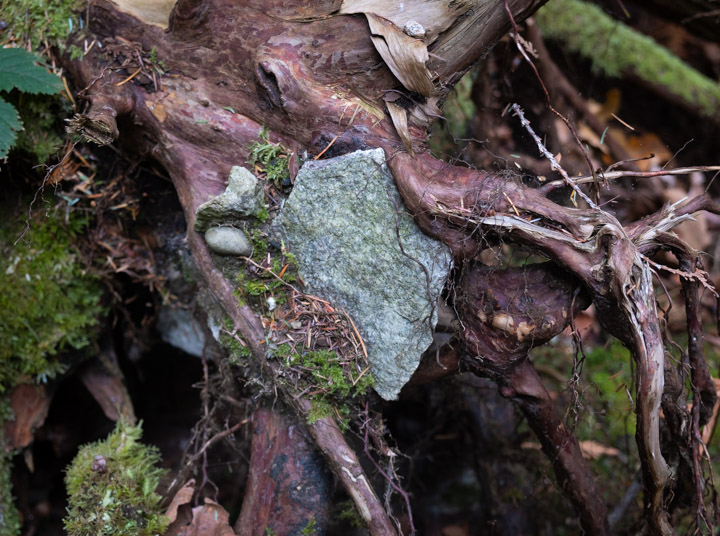
CL XLIII: Still Forest Lives

[This fragment is available in an audio version.]
I’ve said it before: Forests are therapy. So, here are pictures that might please eyes and ease minds. I’ve taken the camera out into these Keats-Island forests many times and who knows, maybe shared shots of the same living plants. Not going to apologize. Come along, let me take your eyes for a walk.
Did I mention therapy? I don’t think it’s controversial to say that we’re years into a dark time for the planet and the soul, and if you’re not feeling the darkness you’re in a better spot than most, definitely than me. No point in running down the dreary list of shared sorrows one more time, we all know the darkness visible in the culture and politics and air and water. And then many have their private personal stressors as well, I’ve mentioned mine. So hey, let’s go out in the woods.
All the plants pictured below are stressed but happy. Everyone has a painful weather story these days; Vancouver’s was two-faced: It didn’t rain between early July and last Friday. The Pacific Northwest is not built for drought. Wildfires set in, and for day after day the smoke and dust were thick and everyone’s throat was scratchy. Trees don’t cry but you can tell when they’re hurting. Two-faced, I said? Well, weeks after weeks of balmy temperatures and clear skies, into October, forsooth. The restaurant and pub patios were full, and the parks and the bike-paths and beaches. It was nice. As in, nice but wrong.
But then it rained! By the time we got to the woods to take these pictures, everything green had had one big generous drink. While trees also don’t sing, the space between them, full of rising damp, felt quietly exuberant.
Trees fall, as must we all some day, going roots-up, and those roots pull along bits of the buried landscape. These are just pretty rocks, but a fair-sized drift-log on our foreshore once had what looked like an old transistor radio lodged down there and I wonder how the hell that happened.
This may have been a forest walk but only this picture is just trees.
This is a youngish Bigleaf Maple (Acer macrophyllum). It’s the only deciduous tree that stands as tall as the great Pacific-Northwest evergreens that surround it. There are no trees I love more. With the onset of rain, finally, these glowing leaves will soon be on their way to rejoin the soil that nourishes the giants.
Let’s look sideways now not up, at a huge round rocky mass that has become entirely coated over the years with moss, which generously leaves space for the occasional fern and certain shrubs which however October has reduced to bare sticks. Since bits-on-the-wire are sorta kinda free these days, I’m offering two image variations; I’m pretty ruthless about tossing out the just-slightly-inferior take on any subject but just couldn’t this time.
All of these pictures are taken with my Fujifilm X-T30 purchased in Hong Kong in 2019. I love the pictures it takes and the Fujifilm lens lineup. The camera did what I wanted when I was hiking many kilometres/day on obscure sections of the Great Wall, but I’ve come to sort of hate it because it’s too small for my big fat Alberta-farm-family hands.
As I write, Fujifilm is in the middle of rolling out a generation of cameras which are going to be better along any measurable dimension than the one that took the pictures you’re looking at.
Except, they’ll be bigger and heavier than this one. But who does lightweight traveling in the Twenties, anyhow? I did for decades, spriting off on an intercontinental jet, often upgraded to a lascivious lie-down compartment. It was great. I’m not saying I’ll never do that again because after all air travel only constitutes 2.5% of the global carbon load. But we all need to ease off.
Ever since I leapt into the Fujifilm ecosystem in 2013, I’ve remarked on how those cameras seem to have a special affinity for pictures with a whole lot of complicated stuff in them. And I’m left a little sad, because these shots in Lightroom on a big screen deliver way more than I can coax out of your web browser.
Consider this leaf. It looks pretty good, but keep zooming in.
I think that’s enough detail, for now.
All the pictures so far have featured a reasonably pure forest setting. Let’s wind up the therapy with a human-sourced hydrangea that lives in front of our cabin and has come through a lot of hard weather and neglect, yet still blesses us with blossoms in mid-October, an instance of the infinitesimally-small benefits of the otherwise-catastrophic onrushing effects of pumping too much carbon into the atmosphere we all rely on to sustain life.
Hang in there. Things suck, but we are not without hope.
Comment feed for ongoing:
From: Doug K (Oct 27 2022, at 14:32)
thanks Tim..
I go to the prairies instead, the forests in CO are too crowded.. see link from my name..
[link]